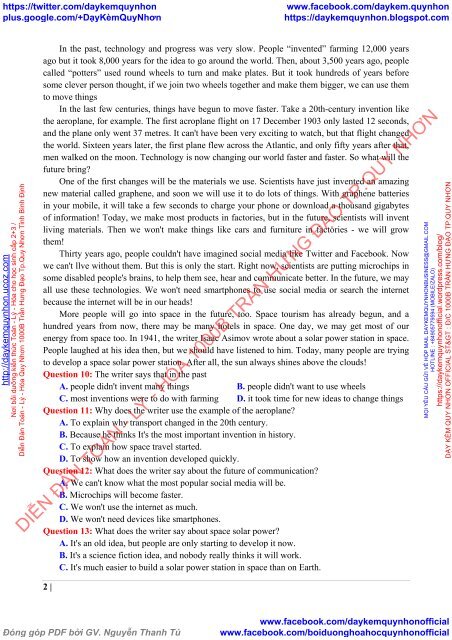Bộ đề thi thử THPTQG 2019 - Môn Toán, Lý, Hóa, Anh - Cả nước - Có lời giải chi tiết (Lần 12) ( 21 đề ngày 01.04.2019 )
https://app.box.com/s/aq6jxik1oqhovk3vxaklhennyfv7fycy
https://app.box.com/s/aq6jxik1oqhovk3vxaklhennyfv7fycy
You also want an ePaper? Increase the reach of your titles
YUMPU automatically turns print PDFs into web optimized ePapers that Google loves.
https://twitter.com/daykemquynhon<br />
plus.google.com/+DạyKèmQuyNhơn<br />
www.facebook.com/daykem.quynhon<br />
https://daykemquynhon.blogspot.com<br />
http://daykemquynhon.ucoz.com<br />
Nơi bồi dưỡng kiến thức <strong>Toán</strong> - <strong>Lý</strong> - <strong>Hóa</strong> cho học sinh cấp 2+3 /<br />
Diễn Đàn <strong>Toán</strong> - <strong>Lý</strong> - <strong>Hóa</strong> Quy Nhơn 1000B Trần Hưng Đạo Tp.Quy Nhơn Tỉnh Bình Định<br />
In the past, technology and progress was very slow. People “invented” farming <strong>12</strong>,000 years<br />
ago but it took 8,000 years for the idea to go around the world. Then, about 3,500 years ago, people<br />
called “potters” used round wheels to turn and make plates. But it took hundreds of years before<br />
some clever person thought, if we join two wheels together and make them bigger, we can use them<br />
to move <strong>thi</strong>ngs<br />
In the last few centuries, <strong>thi</strong>ngs have begun to move faster. Take a 20th-century invention like<br />
the aeroplane, for example. The first acroplane flight on 17 December 1903 only lasted <strong>12</strong> seconds,<br />
and the plane only went 37 metres. It can't have been very exciting to watch, but that flight changed<br />
the world. Sixteen years later, the first plane flew across the Atlantic, and only fifty years after that,<br />
men walked on the moon. Technology is now changing our world faster and faster. So what will the<br />
future bring?<br />
One of the first changes will be the materials we use. Scientists have just invented an amazing<br />
new material called graphene, and soon we will use it to do lots of <strong>thi</strong>ngs. With graphene batteries<br />
in your mobile, it will take a few seconds to charge your phone or download a thousand gigabytes<br />
of information! Today, we make most products in factories, but in the future, scientists will invent<br />
living materials. Then we won't make <strong>thi</strong>ngs like cars and furniture in factories - we will grow<br />
them!<br />
Thirty years ago, people couldn't have imagined social media like Twitter and Facebook. Now<br />
we can't llve without them. But <strong>thi</strong>s is only the start. Right now, scientists are putting micro<strong>chi</strong>ps in<br />
some disabled people's brains, to help them see, hear and communicate better. In the future, we may<br />
all use these technologies. We won't need smartphones to use social media or search the internet<br />
because the internet will be in our heads!<br />
More people will go into space in the future, too. Space tourism has already begun, and a<br />
hundred years from now, there may be many hotels in space. One day, we may get most of our<br />
energy from space too. In 1941, the writer Isaac Asimov wrote about a solar power station in space.<br />
People laughed at his idea then, but we should have listened to him. Today, many people are trying<br />
to develop a space solar power station. After all, the sun always shines above the clouds!<br />
Question 10: The writer says that in the past<br />
A. people didn't invent many <strong>thi</strong>ngs B. people didn't want to use wheels<br />
C. most inventions were to do with farming D. it took time for new ideas to change <strong>thi</strong>ngs<br />
Question 11: Why does the writer use the example of the aeroplane?<br />
A. To explain why transport changed in the 20th century.<br />
B. Because he <strong>thi</strong>nks It's the most important invention in history.<br />
C. To explain how space travel started.<br />
D. To show how an invention developed quickly.<br />
Question <strong>12</strong>: What does the writer say about the future of communication?<br />
A. We can't know what the most popular social media will be.<br />
B. Micro<strong>chi</strong>ps will become faster.<br />
C. We won't use the internet as much.<br />
D. We won't need devices like smartphones.<br />
Question 13: What does the writer say about space solar power?<br />
A. It's an old idea, but people are only starting to develop it now.<br />
B. It's a science fiction idea, and nobody really <strong>thi</strong>nks it will work.<br />
C. It's much easier to build a solar power station in space than on Earth.<br />
DIỄN ĐÀN TOÁN - LÝ - HÓA 1000B TRẦN HƯNG ĐẠO TP.QUY NHƠN<br />
2 |<br />
MỌI YÊU CẦU GỬI VỀ HỘP MAIL DAYKEMQUYNHONBUSINESS@GMAIL.COM<br />
HOTLINE : +84905779594 (MOBILE/ZALO)<br />
https://daykemquynhonofficial.wordpress.com/blog/<br />
DẠY KÈM QUY NHƠN OFFICIAL ST> : Đ/C 1000B TRẦN HƯNG ĐẠO TP.QUY NHƠN<br />
Đóng góp PDF bởi GV. Nguyễn Thanh Tú<br />
www.facebook.com/daykemquynhonofficial<br />
www.facebook.com/boiduonghoahocquynhonofficial

















